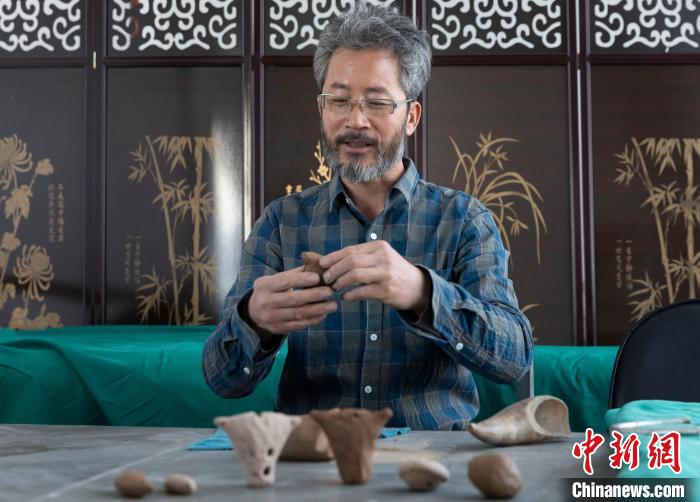Inheritor of intangible cultural heritage recreates thousand-year-old sounds of ancient musical instrument
Niwawu is a traditional folk instrument commonly seen in northwest China’s Ningxia Hui Autonomous Region. The instrument got the name “Niwawu” because it produces sounds similar to “wow” and “woo.” With a history of about 1,000 years, the ancient musical instrument nowadays has been given a new life thanks to the efforts made by a local inheritor.

Photo shows Yang Dawude displaying a Niwawu instrument in the shape of a fish. (Photo/Yang Di)
There are mainly bull head-shaped, ox horn-shaped, fish-shaped and bean-shaped Niwawu instruments that can be found in Ningxia, introduced Yang Dawude, who is an inheritor of the Niwawu. In ancient times, the Niwawu was used to communicate signals in times of war and it was listed as a national intangible cultural heritage item in 2006.
Yang was born into a family that has long been dedicated to the traditional craft of making Niwawu. “My father told me that we have to carry forward the craft that our ancestors gave us,” Yang recalled. In the past, Niwawu produced a narrower range of sounds because only a small number of holes would be carved into the main body of the instruments.
To enable Niwawu to make a wider variety of sounds, more holes needed to be carved into it. After numerous attempted tries, in 2001, Yang finally created a Niwawu instrument that could produce a wider range of sounds. Nowadays, there are 10 holes in Niwawu, which enable the player to flexibly change from one pitch to another, and thus offer a means to play various kinds of music.

Photo shows Yang Dawude making a Niwawu instrument. (Photo/Yang Di)
The raw material used to make Niwawu includes a special kind of clay commonly found in the local area, with the properties of this clay guaranteeing that the instrument will produce a thick melodious sound. There are many procedures involved in the making of Niwawu, including choosing and grinding the clay, molding, tuning the instrument, drying it under shade, and firing it.
In the past, Niwawu instruments were handmade and there were no widely established standards that characterized the techniques adopted. It was Yang who allowed his techniques to be copied for the first time so that the craft could be easily promoted and carried on.

Photo shows Yang Dawude making a Niwawu instrument. (Photo/Yang Di)
Apart from holding lectures on intangible cultural heritage at schools, Yang is also now actively engaged in international cultural exchange activities so that the craft can become more widely known by a larger number of foreigners. He also plans to build a Niwawu museum in his hometown.
Photos
Related Stories
Copyright © 2021 People's Daily Online. All Rights Reserved.










